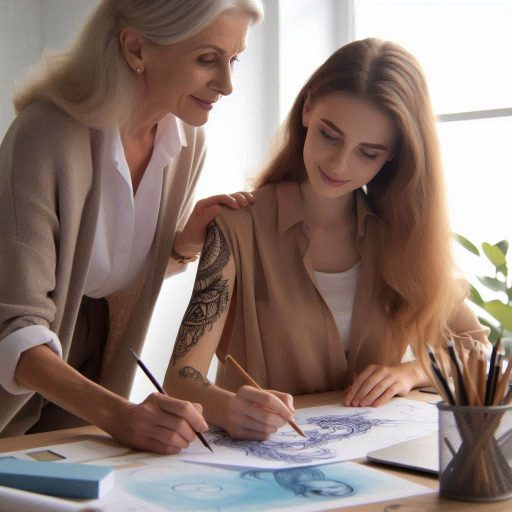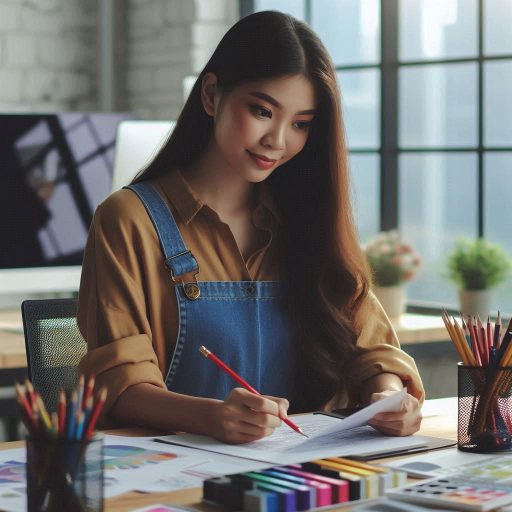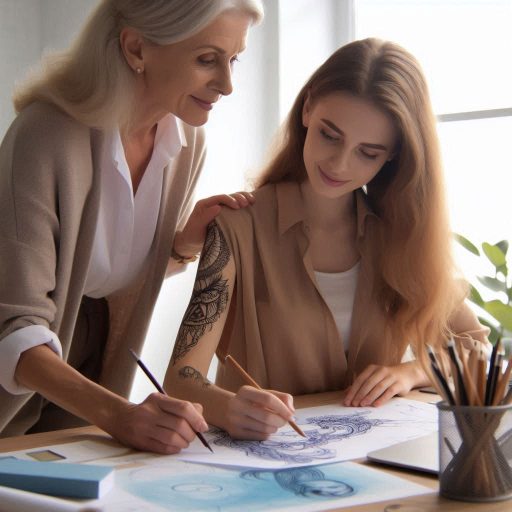Introduction
Introduction to Illustration Trends in the Upcoming Year
Illustration trends evolve rapidly, shaping how artists create and how audiences perceive their work.
Staying updated on these trends is vital for maintaining relevance and creativity in the industry.
As the new year approaches, it’s essential to anticipate which styles and techniques will dominate the field.
Importance of Staying Updated on Current Trends
Keeping up with current illustration trends helps you stay competitive and innovative.
It allows you to adapt to market demands and attract new clients.
Understanding trends also enhances your ability to experiment with new styles and techniques, keeping your work fresh and engaging.
Embracing these trends can set you apart in a crowded marketplace and ensure your artwork resonates with contemporary audiences.
Key Trends to Watch
In the upcoming year, several illustration trends are set to make an impact.
Expect to see more use of vibrant, bold colors and dynamic, abstract compositions.
Retro and nostalgic elements will return, often combined with modern aesthetics.
Additionally, the integration of technology, like augmented reality, will create immersive experiences.
These trends reflect a shift towards both visually striking and interactive art.
Digital Illustration
Discussing the Growing Popularity of Digital Illustration in the Design Industry
Digital illustration is rapidly gaining popularity in the design industry.
Its accessibility and versatility make it a preferred choice for many designers.
The rise of advanced software and tools has simplified the creation of high-quality illustrations.
Designers appreciate the ability to easily make changes and experiment with different styles.
The digital medium also allows for faster turnaround times, meeting tight deadlines effectively.
Digital illustrations are increasingly featured in advertising, branding, and web design.
This trend reflects a shift towards modern, efficient methods of visual creation that align with the industry’s fast-paced demands.
The Benefits of Digital Illustration Compared to Traditional Methods
Digital illustration offers several advantages over traditional methods.
One major benefit is the ease of making edits and revisions.
Unlike physical media, digital tools allow for instant changes without starting from scratch.
Digital platforms also provide access to a wide range of brushes, textures, and effects, enhancing creative possibilities.
Another advantage is the ability to work with layers, which helps in organizing and managing complex designs.
Digital files can be easily stored, shared, and backed up, reducing the risk of loss or damage.
Additionally, digital illustration often involves less material cost, making it a more economical choice for many artists and designers.
Examples of Digital Illustration Trends to Watch for in the Coming Year
Several exciting digital illustration trends are emerging for the coming year.
One trend is the use of augmented reality (AR) to create interactive illustrations.
AR technology allows illustrations to come to life through mobile devices, adding a dynamic element to visual experiences.
Another trend is the rise of 3D digital illustration, which adds depth and realism to designs.
This approach enhances visual storytelling and provides a more immersive experience.
Additionally, minimalist and geometric styles continue to gain traction, focusing on clean lines and simple forms to convey messages effectively.
Finally, the integration of AI tools in digital illustration is becoming more prevalent, enabling artists to automate certain tasks and explore new creative possibilities.
These trends reflect ongoing innovations and the growing influence of technology in the illustration field.
Digital illustration is becoming increasingly popular due to its flexibility, efficiency, and the advanced tools available.
Compared to traditional methods, digital illustration offers easier editing, creative enhancements, and cost savings.
As we look ahead, trends like augmented reality, 3D effects, minimalist styles, and AI integration will shape the future of digital illustration.
Staying updated with these trends allows artists and designers to remain at the forefront of the industry and leverage new technologies in their work.
Minimalism
The Concept of Minimalism in Illustration
Minimalism in illustration emphasizes simplicity and clarity.
It uses fewer elements to create a clean and focused design.
Minimalist illustrations often feature simple shapes, limited color palettes, and ample white space.
This approach removes unnecessary details, highlighting the essence of the subject.
By stripping away complexity, minimalism aims to deliver a clear, impactful message.
The beauty of minimalism lies in its ability to convey powerful ideas with restraint and precision.
This style allows viewers to engage with the artwork without distraction, appreciating the core message through its simplicity.
Discussing How Minimalism Has Been Trending in Various Design Fields
Minimalism has gained significant traction across various design fields in recent years.
In graphic design, it often manifests as clean, straightforward layouts with sparse use of color and typography.
Websites and apps are increasingly adopting minimalist interfaces to enhance usability and focus.
Product design also embraces minimalism, with sleek, unembellished aesthetics dominating the market.
Architecture has similarly shifted towards minimalistic principles, favoring open spaces and simple forms.
The trend towards minimalism reflects a broader cultural movement towards simplicity and functionality.
This shift highlights a desire for clarity and purpose in an increasingly cluttered world.
Examples of Minimalist Illustration Styles That Are Expected to Be Popular in the Upcoming Year
Several minimalist illustration styles are poised to gain popularity in the coming year.
Line art remains a strong contender, using simple, unbroken lines to create detailed yet clean visuals.
This style often emphasizes form and function over elaborate details.
Geometric shapes are another popular minimalist approach, using basic forms to construct visually engaging illustrations.
Monochromatic illustrations, employing a single color or subtle gradients, are also trending, offering a sleek and modern look.
Additionally, abstract minimalism, which employs non-representational shapes and colors, is gaining traction for its versatility and unique aesthetic.
These styles embrace minimalism’s core principles, focusing on essential elements to create striking, effective illustrations.
Embracing these minimalist trends allows illustrators to produce artwork that is both modern and impactful.
By focusing on simplicity and clarity, these styles align with broader design movements and respond to contemporary aesthetic preferences.
As minimalism continues to influence various fields, its principles will likely shape the future of illustration, offering new opportunities for creative expression and design innovation.
Read: Top Skills Needed for Art Educators and Instructors
Bold Colors
Exploring the Use of Bold and Vibrant Colors in Illustration
Bold and vibrant colors are set to dominate illustration trends in the coming year.
These colors bring energy and vitality to artwork, capturing viewers’ attention instantly.
Unlike muted tones, bold colors create strong visual impact and enhance the overall appeal of illustrations.
They convey emotions more vividly and can evoke specific feelings or reactions from the audience.
By embracing bold colors, illustrators can make their work stand out in a crowded market.
Using vibrant colors also allows for greater creativity and experimentation.
Artists can combine striking hues to create dynamic and eye-catching visuals.
This approach can break away from traditional color schemes and explore new, imaginative palettes.
Bold colors can be particularly effective in digital and print media, making illustrations more memorable and engaging.
Discussing How Bold Colors Can Make Artwork Stand Out and Attract Attention
Bold colors are crucial for making artwork stand out and attract attention.
They create high contrast and visual interest, drawing viewers’ eyes to key elements of the illustration.
For example, a bright, contrasting color can highlight important aspects of a design or illustration.
This technique can make certain elements pop and grab the viewer‘s focus.
In addition to grabbing attention, bold colors can also differentiate your work from others.
With many artists and designers using similar color palettes, bold choices help your illustrations stand out in a sea of imagery.
By using striking and unconventional colors, you can create a unique visual identity that sets your work apart.
The use of bold colors can also be a powerful tool in branding and marketing.
Illustrations with vibrant colors are more likely to be remembered and recognized.
This memorability can enhance brand recognition and strengthen visual communication.
Whether for personal projects or client work, incorporating bold colors can make a lasting impression.
Showcasing Upcoming Color Trends and Palettes That Illustrators Can Experiment With
As we look ahead, several color trends are emerging that illustrators can experiment with.
One trend is the use of neon colors, which offer a futuristic and energetic vibe.
Neon pinks, greens, and blues can add a vibrant, high-energy feel to your illustrations.
These colors are particularly effective for digital art and modern design projects.
Another trend is the resurgence of retro color palettes.
Colors like mustard yellow, teal, and burnt orange are making a comeback.
These vintage hues add a nostalgic and warm touch to illustrations, creating a sense of comfort and familiarity.
Pastel colors are also gaining popularity.
Soft, pastel shades provide a calming and soothing effect.
They can be used to create gentle, ethereal visuals that appeal to audiences seeking tranquility.
Experimenting with pastel palettes can add a delicate and refined quality to your work.
Additionally, the trend of color gradients continues to evolve.
Gradients that blend bold and subtle hues create depth and dimension in illustrations.
This technique adds a modern and sophisticated touch to artwork, making it visually engaging and complex.
In summary, bold and vibrant colors are key to staying relevant in illustration trends.
They make artwork stand out, attract attention, and offer numerous creative possibilities.
By exploring upcoming color trends and experimenting with new palettes, illustrators can enhance their work and captivate their audience.
Embrace these color trends to keep your illustrations fresh, dynamic, and engaging.
Read: Collaborating with Other Creative Roles
Mixed Media
Combining Different Media in Illustration
Illustration trends in the coming year highlight the fusion of different media.
Combining digital and traditional techniques creates dynamic and unique artworks.
This approach merges the best of both worlds, offering versatility and depth.
Digital tools offer precision and ease, while traditional techniques bring texture and a personal touch.
Illustrators are blending these methods to push creative boundaries.
For instance, artists might start with digital sketches and then add hand-painted elements or textures.
This trend allows for greater experimentation.
By integrating various media, illustrators can achieve more nuanced and engaging results.
Combining media also provides more opportunities for innovation and originality in illustration.
Unique Visual Effects Through Mixed Media
Mixed media in illustration creates unique visual effects that stand out.
The interaction between different materials adds layers of depth and complexity.
For example, combining watercolor with digital enhancements can produce vibrant and fluid designs.
Traditional materials like ink and collage can bring a tactile quality to digital work.
This combination can result in illustrations that feel both contemporary and nostalgic.
Textures from physical media add richness and authenticity to the final image.
The use of mixed media also allows for creative problem-solving.
Artists can address challenges by combining techniques that offer different strengths.
This approach results in visually compelling and technically diverse illustrations.
Examples of Mixed Media Illustrations to Watch
Several examples of mixed media illustrations are expected to gain popularity in the coming year.
One notable example is the fusion of digital and watercolor techniques.
Artists might create detailed digital outlines and then enhance them with watercolor textures for a more organic feel.
Another trend is the use of digital tools to manipulate traditional collage elements.
Artists can scan physical collages and then digitally layer and adjust them.
This method results in intricate, multi-dimensional illustrations that stand out.
Additionally, incorporating 3D elements into 2D illustrations is gaining traction.
Artists are combining traditional drawing with digital 3D modeling to create depth and perspective.
This technique adds a new dimension to illustrations, making them more immersive and engaging.
Lastly, integrating hand-drawn typography with digital backgrounds is a growing trend.
Illustrators are combining custom lettering with digital patterns and textures.
This mix enhances visual interest and adds a personalized touch to the design.
In fact, the trend of combining different media in illustration is set to be prominent in the coming year.
By merging digital and traditional techniques, illustrators can achieve unique visual effects and innovative results.
Examples such as digital and watercolor fusion, digital manipulation of physical collages, and the integration of 3D elements showcase the exciting possibilities of mixed media in illustration.
Embracing these trends can lead to fresh and captivating artwork that stands out in a competitive field.
Read: Historic Costume Design Inspirations

Retro Revival
Discussing the Resurgence of Retro and Vintage Styles in Illustration
Retro and vintage styles are making a strong comeback in the illustration world.
This resurgence reflects a growing appreciation for the aesthetics of past decades.
Illustrators are revisiting and reinterpreting design elements from the 1950s, 1960s, and 1970s, blending them with modern techniques.
This trend is characterized by bold color palettes, nostalgic patterns, and classic typography.
The vintage look evokes a sense of nostalgia and timelessness that resonates with contemporary audiences.
Exploring How Illustrators Are Incorporating Nostalgic Elements into Their Work
Illustrators are creatively incorporating nostalgic elements into their work, blending past aesthetics with present-day sensibilities.
They are drawing inspiration from old advertisements, comic books, and retro packaging.
This involves using retro color schemes, such as muted pastels and earthy tones, and applying vintage textures, like grain and noise.
Illustrators are also embracing traditional techniques, such as hand-drawn lines and analog textures, to enhance the nostalgic feel.
One popular approach is using vintage-inspired motifs, such as retro typography, geometric shapes, and classic iconography.
These elements are often combined with modern design principles to create a fresh yet familiar look.
For instance, illustrators might use retro color gradients alongside contemporary flat design elements.
This fusion of old and new creates visually striking illustrations that appeal to both nostalgic and modern tastes.
Transform Your Career Today
Unlock a personalized career strategy that drives real results. Get tailored advice and a roadmap designed just for you.
Start NowShowcasing Examples of Retro-Inspired Illustrations That Are Predicted to Be Trendy in the Upcoming Year
Several examples highlight the trend of retro-inspired illustrations that are set to be popular in the coming year.
One example is the revival of 1980s neon aesthetics, characterized by vibrant, glowing colors and futuristic fonts.
This style is making a comeback in various media, including digital art and print design.
Illustrators are reimagining neon signs and retro technology with a modern twist.
Another example is the use of mid-century modern design elements, such as clean lines and abstract shapes.
This style, known for its simplicity and elegance, is being integrated into contemporary illustrations to evoke a sense of nostalgia while maintaining a fresh appearance.
Illustrators are using mid-century color palettes and patterns to create visually engaging artwork.
Additionally, retro-inspired illustrations featuring vintage travel posters and old-school advertising motifs are trending.
These illustrations often showcase classic travel destinations and products with a nostalgic flair.
By incorporating retro typography and color schemes, these artworks capture the charm of bygone eras.
One notable trend is the use of retro comic book styles, characterized by halftone dots and bold, graphic lines.
Illustrators are channeling the aesthetics of classic comic books to create dynamic and eye-catching designs.
This style appeals to audiences who appreciate the visual storytelling of vintage comics.
The resurgence of retro and vintage styles in illustration is set to continue making waves.
By incorporating nostalgic elements and reimagining classic aesthetics, illustrators are creating captivating work that bridges the past and present.
Keep an eye out for these retro-inspired trends as they gain popularity in the coming year.
Read: Breaking Down Iconic Movie Costumes
See Related Content: Successful Creative Directors Share Their Journey
Nature-Inspired
Highlighting the Influence of Nature and Natural Elements on Illustration Trends
Nature and natural elements are increasingly influencing illustration trends.
As people become more eco-conscious, nature-inspired art is gaining popularity.
This trend reflects a broader cultural shift towards environmental awareness and appreciation of the natural world.
Illustrators are embracing natural themes to connect with audiences who value sustainability and organic beauty.
Nature‘s textures, colors, and forms provide endless inspiration for creating visually striking and meaningful artwork.
Incorporating natural elements into illustrations helps artists explore new dimensions in their work.
It allows them to experiment with organic shapes, patterns, and color palettes.
This approach brings a fresh, earthy feel to designs, contrasting with more digital or abstract styles.
The influence of nature on illustration trends highlights a growing desire for authenticity and connection with the environment.
Discussing How Illustrators Are Incorporating Botanical, Floral, and Organic Motifs into Their Work
Illustrators are increasingly incorporating botanical, floral, and organic motifs into their creations.
These elements add depth, texture, and a sense of tranquility to their work.
Botanical illustrations capture the intricate details of plants, from the delicate veins of leaves to the vibrant hues of flowers.
Floral motifs bring a timeless elegance, often used in both contemporary and traditional styles.
Organic shapes, inspired by natural forms, offer a fluid and dynamic quality to illustrations.
These shapes often mimic the irregularities and imperfections found in nature, creating more relatable and engaging designs.
Illustrators use these motifs to evoke feelings of calm and connection to the natural world.
The inclusion of these elements reflects a trend towards more organic and earthy visual aesthetics.
Artists are also exploring the integration of nature with other artistic styles.
Combining botanical elements with abstract or surreal compositions creates a unique visual impact.
This fusion allows for creative expression while maintaining a connection to nature.
Such experimentation is driving innovation in how natural themes are represented in art.
Examples of Nature-Inspired Illustrations That Are Expected to Be Popular in the Coming Year
In the coming year, several nature-inspired illustration styles are expected to gain traction.
Illustrations featuring intricate botanical patterns will remain popular.
Artists are creating detailed depictions of plants and flowers, showcasing their textures and colors in vibrant ways.
These works often appear in editorial design, packaging, and home decor.
Floral illustrations, with their bright and varied palettes, are also trending.
Expect to see large, bold flower prints and delicate, watercolor-style flowers.
These designs are used in a range of applications from textiles to digital media.
The timeless appeal of florals ensures their continued popularity across different platforms.
Organic motifs, such as abstract representations of natural forms, are becoming more prevalent.
Illustrators are experimenting with shapes inspired by the natural world, such as flowing lines and irregular patterns.
These designs evoke a sense of fluidity and natural rhythm, making them ideal for modern, minimalistic aesthetics.
Additionally, nature-inspired illustrations featuring wildlife are gaining attention.
Illustrations depicting animals in their natural habitats or stylized representations of wildlife bring an element of storytelling to the artwork.
These illustrations often emphasize conservation themes, aligning with a growing interest in environmental issues.
Nature and natural elements are shaping the illustration trends of the coming year.
Botanical, floral, and organic motifs offer new avenues for creativity and expression.
By integrating these elements into their work, illustrators create visually appealing and meaningful art that resonates with contemporary values and aesthetics.
Diversity and Inclusion
Addressing the Importance of Diversity and Representation in Illustration
Diversity and representation are crucial elements in contemporary illustration.
As societies become more inclusive, artwork should reflect this change.
Illustrations that embrace a range of cultures, identities, and experiences help foster a sense of belonging.
They challenge stereotypes and promote understanding across different groups.
A diverse representation in illustrations ensures that all individuals feel seen and valued.
Artists have the power to influence perceptions and drive cultural change through their work.
By representing various backgrounds and perspectives, illustrators contribute to a broader and more inclusive narrative.
This practice not only enriches the art world but also responds to the growing demand for content that resonates with a global audience.
Embracing diversity in illustrations aligns with evolving societal values and supports the quest for equality and acceptance.
Discussing How Illustrators Are Creating More Inclusive and Diverse Artwork
Illustrators are increasingly focused on creating inclusive and diverse artwork.
They are actively incorporating different cultures, gender identities, and backgrounds into their illustrations.
This shift reflects a broader movement towards representation in the arts and media.
Artists are using their platforms to highlight stories and experiences that were previously underrepresented.
Modern illustrators are drawing from a wider range of sources for inspiration.
They engage with communities and individuals to ensure accurate and respectful portrayals.
This involves researching cultural symbols, traditions, and practices to avoid appropriation and misrepresentation.
Illustrators are also collaborating with diverse teams to gain insights and perspectives that enhance the authenticity of their work.
Digital tools and social media have amplified these efforts.
Platforms like Instagram and Behance allow illustrators to showcase their diverse work and connect with global audiences.
These tools also facilitate dialogue about representation and inclusivity, driving further innovation in the field.
As a result, the art world is seeing a richer array of perspectives and stories in illustrations.
Showcasing Examples of Illustrations That Celebrate Different Cultures, Identities, and Perspectives
Several noteworthy examples illustrate the trend towards celebrating diversity in illustration.
For instance, artist Laolu Senbanjo creates vibrant, culturally rich artwork that celebrates traditional African patterns and folklore.
Their illustrations feature bold colors and intricate designs that honor and explore African heritage.
Another example is Rafael Soldi, who specializes in LGBTQ+ representation.
Their work includes colorful, expressive portraits that highlight various identities and experiences within the LGBTQ+ community.
By focusing on inclusive themes, their illustrations foster a sense of pride and visibility.
Illustrator Yuko Shimizu focuses on blending elements from different cultural backgrounds to create fusion art.
Their illustrations merge Eastern and Western styles, producing visually striking works that celebrate cultural diversity.
This approach not only showcases artistic skill but also reflects a globalized, interconnected world.
Finally, Lauren Silva creates illustrations that represent individuals with disabilities.
Their artwork highlights the daily lives and achievements of people with various physical and cognitive challenges.
By focusing on accessibility and representation, their illustrations contribute to a more inclusive art landscape.
The importance of diversity and representation in illustration is becoming increasingly recognized.
Illustrators are creating more inclusive and diverse artwork, reflecting a broad spectrum of cultures, identities, and perspectives.
Through these efforts, they contribute to a richer, more equitable art world that resonates with a global audience.
Conclusion
In the coming year, several key illustration trends are emerging.
Expect to see vibrant, bold color palettes dominating artwork.
Dynamic, fluid lines and abstract shapes are gaining popularity, adding energy to designs.
3D elements and animations are increasingly integrated into illustrations, creating immersive experiences.
Illustrators are also exploring retro and nostalgic styles, infusing their work with a sense of timelessness.
Encourage yourself to stay inspired by these trends and experiment with different styles.
Trying new techniques can spark creativity and expand your artistic range.
Embrace the evolving trends to keep your work fresh and engaging.
Keeping up with industry trends is crucial for staying relevant and innovative.
Regularly explore new styles and techniques to ensure your work stands out.
Following trends helps you adapt to changing preferences and maintain a competitive edge.
Stay proactive in seeking out new inspirations and integrating them into your illustrations.
By experimenting with these emerging trends, you can enhance your creative process and appeal to modern audiences.
Embrace change and continually evolve to stay at the forefront of the illustration industry.




